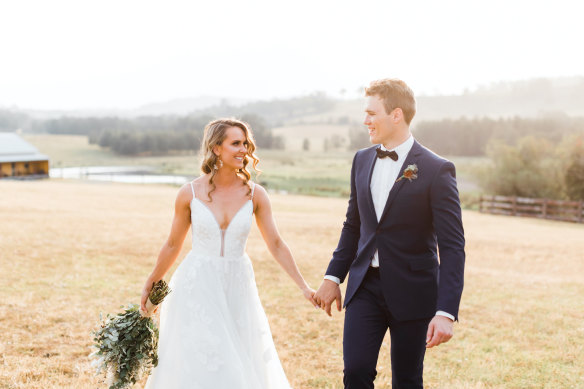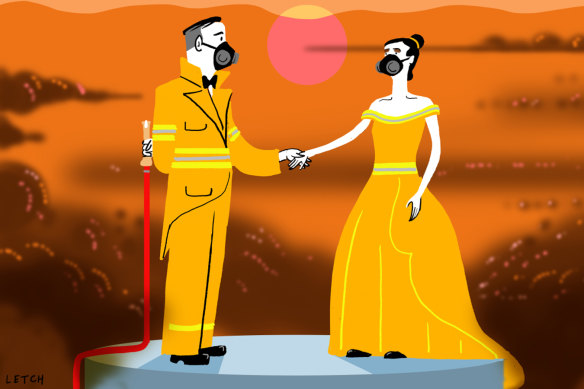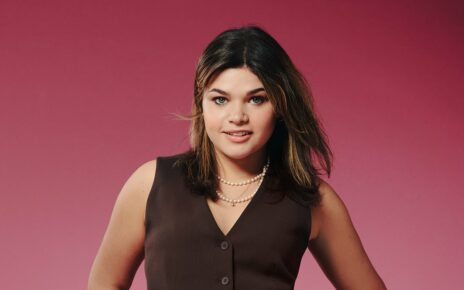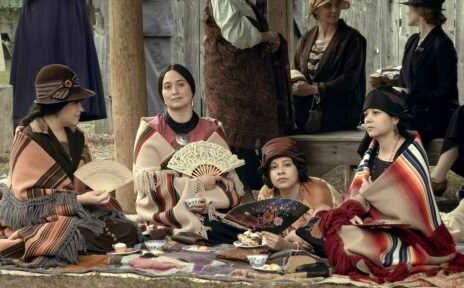Save articles for later
Add articles to your saved list and come back to them any time.
On the day of her wedding, Alissa McGovern woke up to thick smoke, unrelenting heat and a sun burning bright and red. “I remember taking pictures [of the sun], because it was just such an unusual sight.”
It was November 2019 – the beginning of what would become known as Black Summer – and fires had been burning near their wedding venue in Paterson, in the lower Hunter Region of NSW. While McGovern and her husband Liam were able to proceed with the wedding, had they chosen to marry a week later, they wouldn’t have been so lucky when fires burned through the town.
Alissa McGovern and her husband Liam on their wedding day. A thick haze of smoke from nearby bushfires can be seen in the background.Credit: Stories With Mel
The day was “ridiculously hot”, with McGovern sweltering in her layered gown and Liam in his suit. While they were shaded by a fig tree for their ceremony, a guest – who had been standing in the sun – fainted. Ultimately, she’s glad the day went ahead the way it did.
This September, the Bureau of Meteorology declared El Nino, meaning those tying the knot this summer are likely in for a hot, dry wedding day like McGovern’s. Experts are also anticipating longer, more intense bushfires.
But the threat of natural disasters isn’t deterring couples, according to Amy Parfett, co-founder of online wedding directory Wedshed, who says the demand for regional weddings is only growing.
Parfett adds that businesses are becoming much more accommodating to last-minute changes due to weather. “One of the silver linings of the pandemic is that businesses in the wedding industry have updated their policies on what they’re going to do should something unforeseen happen,” says Parfett.
And many climate-affected businesses and venues are diversifying into the wedding space.
“They’re saying, ‘OK, we’ve got this beautiful location that we’re sitting on. Why don’t we introduce a new revenue stream and open things up to future-proof this place against what the climate is going to do to our farm,’” says Parfett.
In 2020, Lowe Family Wine Company, a winery, vineyard and farm in Mudgee, NSW, lost their entire vintage to smoke from nearby bushfires. They started hosting weddings officially that same year, something Lachlan Garland, the company’s general manager, says has helped recuperate lost revenue.
“We are very fortunate to be in a low-risk fire zone and we don’t have a lot of bush around us. We also have multiple routes in and out of the property and strong evacuation plans in place.”
The time of year couples are choosing to wed is also shifting. Melanie James, a wedding planner who works across Melbourne and regional Victoria, says while January has never been a popular month, she’s noticing more couples push their weddings further towards autumn.
Parfett says winter is becoming more popular – which may also be a response to the rising cost of living as venues will often offer off season discounted rates.
The venue
It’s popular for couples to take a hybrid approach, says Parfett, holding an indoor ceremony and outdoor reception, or vice versa. When shopping around, make sure you’re aware of their amenities – such as air-conditioning and industrial misters – and what their evacuation plan is.
It’s officially El Nino. Here’s how to plan your wedding.Credit: Simon Letch
“Make sure there’s adequate transport on standby if the weather’s looking unfavourable,” says Parfett, “and stay in constant communication with your venue because it’s their responsibility to be on top of what the weather alerts are in their local region too.”
And if you have your heart set on an outdoor wedding, James says it’s a good idea to have an indoor, back-up venue should things take a turn.
On the day
Little touches can make all the difference to keep guests cool and comfortable.
“Don’t just rely on bar or wait staff to be able to get water from the bar [for guests]. Make sure you have non-alcoholic areas with tubs of sparkling and still water bottles,” says Parfett.
Garland adds that when hosting weddings, they’ll offer guests a non-alcoholic drink on arrival, and try to wait until after the ceremony to start serving alcohol.
To help keep guests comfortable, James suggests handing out fans or individual water misters, and having sunscreen and eye drops on offer if the air quality is poor.
James says hardier flowers, like natives, are preferable as they are less likely to wilt. And buttercream should be avoided at all costs.
Hair, make-up and everything else
Tara Airlie is director of Airlie&Co, a mobile hair and make-up team that specialises in weddings. If you’re prone to sweat, she suggests something like a bun that’s on trend at the moment. “This keeps the neck cool and in heat your hair is much more likely to stay in place.” She adds that heat can cause hair products to deteriorate quickly, so you can get away with using a little more than normal.
When it comes to make-up, keep it simple and go for long-wearing products. “Layering too many products means they’ll slip and side on your face.”
She also recommends using a setting spray with temperature control technology. Airlie uses Urban Decay’s All Nighter Setting Spray that “keeps the face cool so make-up won’t melt and spread in the heat.”
Another tip she gives brides is to choose robes made from natural fibres that are more breathable and won’t cause them to sweat as much while getting ready.
Airlie also encourages couples to think about how they can use accessories to their advantage. Heart-shaped sunglasses can be a fun option for photos or the reception, and parasols – perhaps of the white, lace variety – are attractive and can be held by the bridal party during the ceremony.
Make the most of your health, relationships, fitness and nutrition with our Live Well newsletter. Get it in your inbox every Monday.
Most Viewed in Lifestyle
From our partners
Source: Read Full Article




